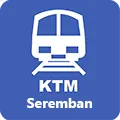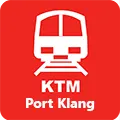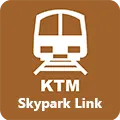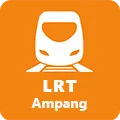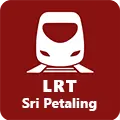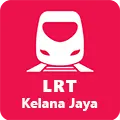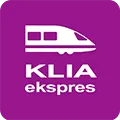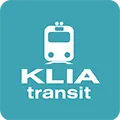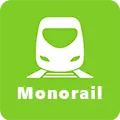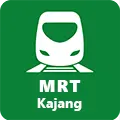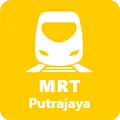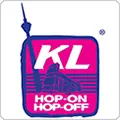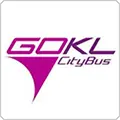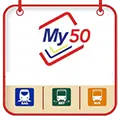Greater Kuala Lumpur / Klang Valley Integrated Transit System is an integrated transport network that primarily serves the area of Klang Valley and Greater Kuala Lumpur.
The system currently consists of 11 fully operating rail lines; 2 commuter rail lines, 5 rapid transit lines, 1 bus rapid transit line and 2 airport rail links to the Kuala Lumpur International Airport (and its low-cost terminal klia2) and another one to the Sultan Abdul Aziz Shah Airport.
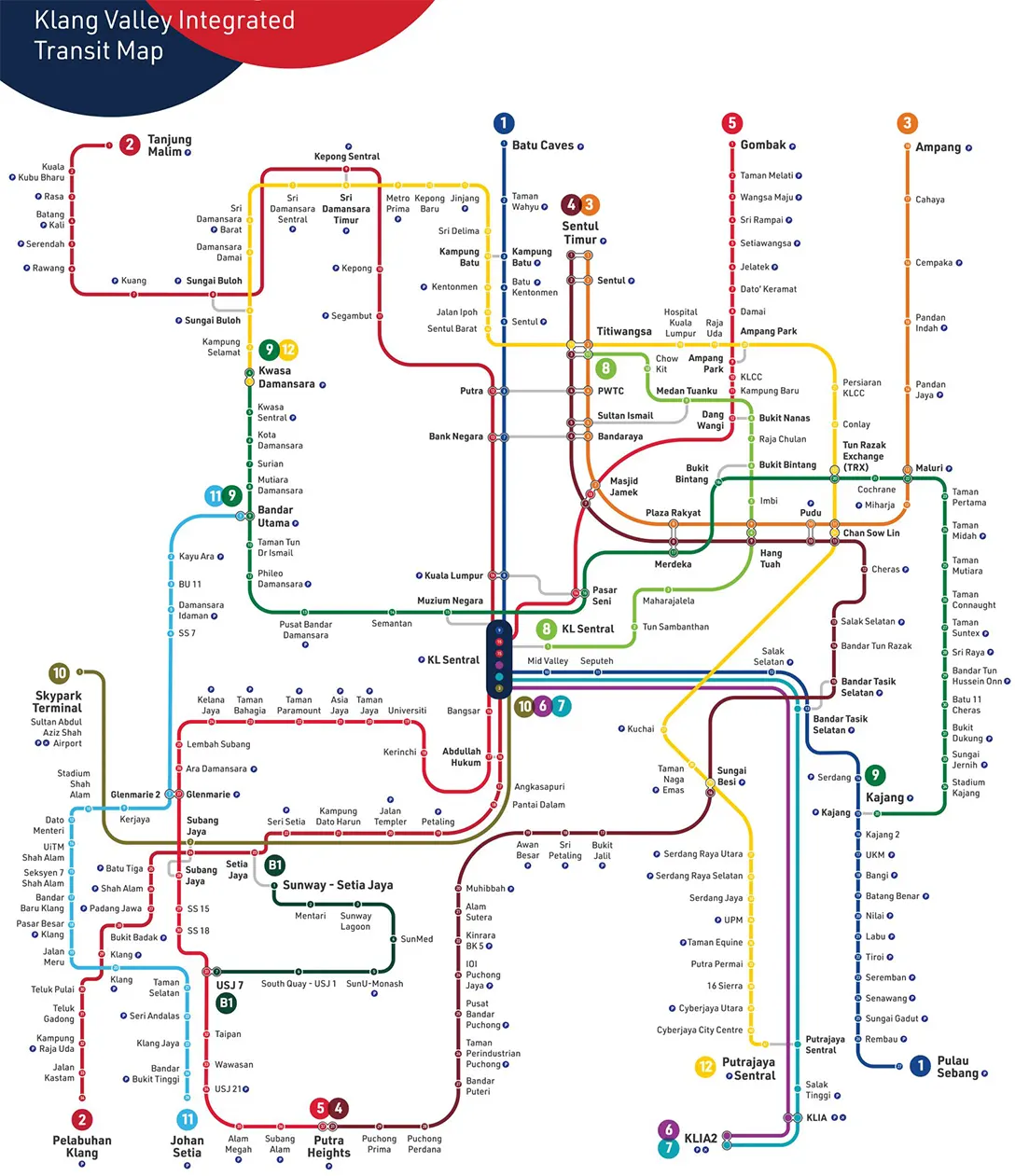
The Greater Kuala Lumpur / Klang Valley Integrated Transit System consists of these Light Rail Transit (LRT) systems – the ![]() Ampang Line LRT, the
Ampang Line LRT, the ![]() Sri Petaling Line LRT and the
Sri Petaling Line LRT and the ![]() Kelana Jaya Line LRT – operated by Rapid Rail Sdn Bhd.
Kelana Jaya Line LRT – operated by Rapid Rail Sdn Bhd.
The integrated transit system also includes three commuter rail lines (along with shuttle services) operated as the ![]() KTM Komuter – Seremban Line,
KTM Komuter – Seremban Line, ![]() KTM Komuter – Port Klang Line and
KTM Komuter – Port Klang Line and ![]() KTM Komuter – Skypark Link, plus one Monorail line known as the
KTM Komuter – Skypark Link, plus one Monorail line known as the ![]() KL Monorail.
KL Monorail.
In addition, an airport rail links to the Kuala Lumpur International Airport (KLIA) and klia2, which consists of the ![]() KLIA Ekspres and the
KLIA Ekspres and the ![]() KLIA Transit ERL services.
KLIA Transit ERL services.
The MRT-based public transport network, 51km ![]() MRT Kajang Line, was integrated to the Klang Valley Mass Rapid Transit (KVMRT) project in 2017.
MRT Kajang Line, was integrated to the Klang Valley Mass Rapid Transit (KVMRT) project in 2017.
The ![]() MRT Putrajaya Line is the second line of the KVMRT Project to be developed after the successful completion of first line — MRT Kajang Line in July 2017. The MRT Putrajaya Line complete operations began from 16th March 2023.
MRT Putrajaya Line is the second line of the KVMRT Project to be developed after the successful completion of first line — MRT Kajang Line in July 2017. The MRT Putrajaya Line complete operations began from 16th March 2023.
BHistory of Greater Kuala Lumpur / Klang Valley Integrated Transit System
The timeline for the development of Kuala Lumpur / Klang Valley Integrated Transit System is as follow:
| Klang Valley Integrated Transit System Timeline | |
|---|---|
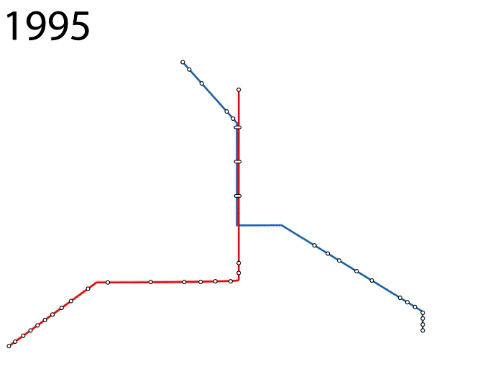
The ![]() KTM Komuter Seremban Line began as part of the Selangor Government Railway which opened in 1886. The
KTM Komuter Seremban Line began as part of the Selangor Government Railway which opened in 1886. The ![]() KTM Komuter Port Klang Line began as the Selangor Government Railway which connected Bukit Kuda just outside Klang to Kuala Lumpur, opened in September 1886.
KTM Komuter Port Klang Line began as the Selangor Government Railway which connected Bukit Kuda just outside Klang to Kuala Lumpur, opened in September 1886.
Both lines switched to the electrified commuter train service in 1995.
Effective from 15 December 2015, the original Port Klang Line from Batu Caves – Port Klang was changed to Rawang – Port Klang whereas the original route for Seremban Line from Rawang – Seremban was changed to Batu Caves – Seremban.
The ![]() Ampang Line and
Ampang Line and ![]() Sri Petaling Line were introduced in 1996 as a single train line originating at Sentul Timur station, with two branches to Ampang and Sri Petaling via Chan Sow Lin station.
Sri Petaling Line were introduced in 1996 as a single train line originating at Sentul Timur station, with two branches to Ampang and Sri Petaling via Chan Sow Lin station.
The ![]() Kelana Jaya Line comprises 46.4km of grade-separated tracks running mostly on underground and elevated guideways with 37 stations was introducted in 1998.
Kelana Jaya Line comprises 46.4km of grade-separated tracks running mostly on underground and elevated guideways with 37 stations was introducted in 1998.
The ![]() ERL KLIA Ekspres and
ERL KLIA Ekspres and ![]() ERL KLIA Transit are commuter rail service introduced in 2002 to serves as the airport rail link to the Kuala Lumpur International Airport (KLIA) in Malaysia.
ERL KLIA Transit are commuter rail service introduced in 2002 to serves as the airport rail link to the Kuala Lumpur International Airport (KLIA) in Malaysia.
| Stations for KLIA Transit |
|---|
Both KLIA Ekspres and KLIA Transit operate from KL Sentral, the main railway station of Kuala Lumpur, to Kuala Lumpur International Airport Terminal 1 (KLIA) as well as the low-cost terminal, Terminal 2 (klia2).
On 31 August 2003, the urban ![]() Monorail Line was introduced with 11 stations running 8.6 km on two parallel elevated tracks.
Monorail Line was introduced with 11 stations running 8.6 km on two parallel elevated tracks.
The Monorail Line connects the KL Sentral transport hub in the south and Titiwangsa in the north with the “Golden Triangle”, a commercial, shopping, and entertainment area consisting of the Bukit Bintang area, and surrounded by Jalan Imbi, Jalan Bukit Bintang, Jalan Sultan Ismail, and Jalan Raja Chulan.
Initially, different competing companies had operated the various systems and had developed these rail systems separately and at different times.
As a result, many of these rail lines do not integrate well with the others or with the overall rail system itself, making transferring from system to system inconvenient for the passengers.
Since 28 November 2011, the paid areas of shared stations along the Kelana Jaya Line LRT, Ampang and Sri Petaling line LRTs, plus the KL Monorail from 1 March 2012, have been integrated physically under a common ticketing system, effectively making those stations into interchange stations.
With the addition of the latest rapid transit line on 17 July 2017, the ![]() MRT Kajang Line, the integrated system has been further expanded to enable commuters to transfer between lines the interchange stations without buying a new ticket each time.
MRT Kajang Line, the integrated system has been further expanded to enable commuters to transfer between lines the interchange stations without buying a new ticket each time.
The ![]() MRT Kajang Line spans a total length of 47km and it runs underground for a distance of 9.5km beneath the centre of Kuala Lumpur while the rest of the alignment is elevated. The line has 30 stations of which 7 are underground station and 1 is provisional station (Bukit Kiara).
MRT Kajang Line spans a total length of 47km and it runs underground for a distance of 9.5km beneath the centre of Kuala Lumpur while the rest of the alignment is elevated. The line has 30 stations of which 7 are underground station and 1 is provisional station (Bukit Kiara).
| Stations for MRT Kajang Line |
|---|
The MRT (Mass Rapid Transit) Kajang Line aims to connect from the north west region of Kuala Lumpur, e.g. Sungai Buloh, Damansara to the south east region of Kuala Lumpur, e.g. Cheras, Kajang through the heart of the Kuala Lumpur City Centre.
However, the fare integration for the Rapid KL rail integrated system does not include other rail systems such as KTM Komuter and Express Rail Link.
The 26km ![]() Skypark Link commenced operations on 1 May 2018 and runs between KL Sentral and Subang Skypark Terminal with a stop in Subang Jaya.
Skypark Link commenced operations on 1 May 2018 and runs between KL Sentral and Subang Skypark Terminal with a stop in Subang Jaya.
The ![]() MRT Putrajaya Line is the second line of the KVMRT Project to be developed after the successful completion of first line — MRT Kajang Line in July 2017. It started full operations from March 16, 2023.
MRT Putrajaya Line is the second line of the KVMRT Project to be developed after the successful completion of first line — MRT Kajang Line in July 2017. It started full operations from March 16, 2023.
The MRT Putrajaya alignment spans a total length of 57.7km, consisting of 44.2km of elevated tracks and 13.5km running through underground tunnels. It has 39 operational stations of which 30 stations are elevated stations and 9 underground stations.
The MRT Putrajaya Line is intended to serve a corridor with a population of around 2 million people stretching from Kwasa Damansara, a new township development in northwest Kuala Lumpur, spanning densely populated areas to its southern suburbs, and finally to Putrajaya, Malaysia’s federal administrative centre.
The ![]() LRT Shah Alam Line or LRT 3, is a medium-capacity light rapid transit (LRT) line which will be serving the Shah Alam and Klang regions on the western side of the Klang Valley, Malaysia. It is scheduled to be operational in 2024.
LRT Shah Alam Line or LRT 3, is a medium-capacity light rapid transit (LRT) line which will be serving the Shah Alam and Klang regions on the western side of the Klang Valley, Malaysia. It is scheduled to be operational in 2024.

Site Search
Did you find what you are looking for? Try out the enhanced Google Search:
